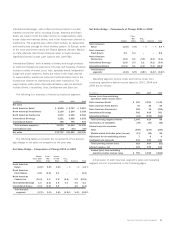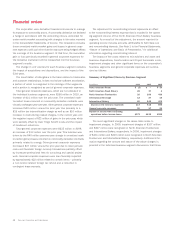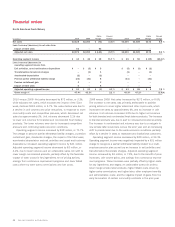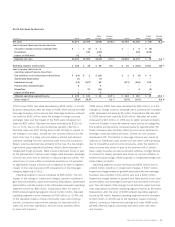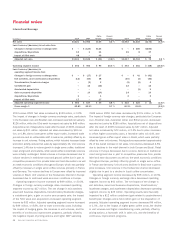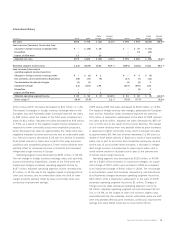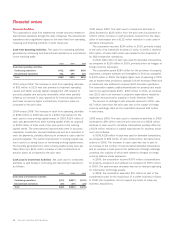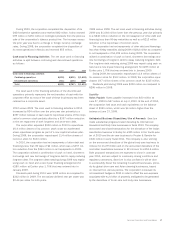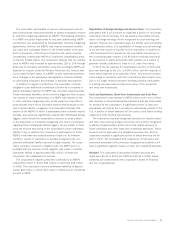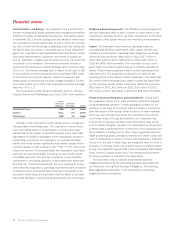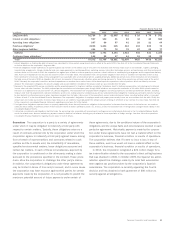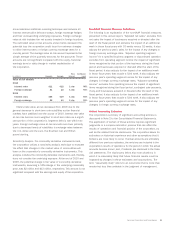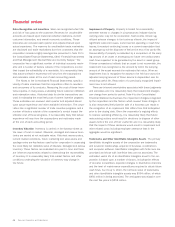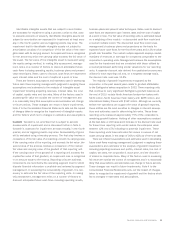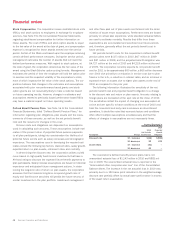Sara Lee 2010 Annual Report Download - page 41
Download and view the complete annual report
Please find page 41 of the 2010 Sara Lee annual report below. You can navigate through the pages in the report by either clicking on the pages listed below, or by using the keyword search tool below to find specific information within the annual report.The corporation participates in various multi-employer pension
plans that provide retirement benefits to certain employees covered
by collective bargaining agreements (MEPP). Participating employers
in a MEPP are jointly responsible for any plan underfunding. MEPP
contributions are established by the applicable collective bargaining
agreements; however, the MEPPs may impose increased contribu-
tion rates and surcharges based on the funded status of the plan
and the provisions of the Pension Protection Act, which requires
substantially underfunded MEPPs to implement rehabilitation plans
to improve funded status. The corporation believes that its contribu-
tions to MEPPs may increase by approximately 12% to 15% through
2011 due to increased contribution rates and surcharges MEPPs are
expected to impose under the Pension Protection Act. Factors that
could impact funded status of a MEPP include investment perform-
ance, changes in the participant demographics, financial stability
of contributing employers and changes in actuarial assumptions.
In addition to regular contributions, the corporation could be
obligated to pay additional contributions (known as a complete or
partial withdrawal liability) if a MEPP has unfunded vested benefits.
These withdrawal liabilities, which would be triggered if the corpora-
tion ceases to make contributions to a MEPP with respect to one
or more collective bargaining units, would equal the corporation’s
proportionate share of the unfunded vested benefits based on the
year in which liability is triggered. The corporation believes that
certain of the MEPPs in which it participates have unfunded vested
benefits, and some are significantly underfunded. Withdrawal liability
triggers could include the corporation’s decision to close a plant
or the dissolution of a collective bargaining unit. Due to uncertainty
regarding future withdrawal liability triggers, we are unable to deter-
mine the amount and timing of the corporation’s future withdrawal
liability, if any, or whether the corporation’s participation in these
MEPPs could have any material adverse impact on its financial
condition, results of operations or liquidity. Disagreements over
potential withdrawal liability may lead to legal disputes. The corpo -
ration currently is involved in litigation with one MEPP and it is
probable that the outcome of this litigation may result in a partial
withdrawal liability of approximately $22 million, of which the
corporation has established an accrual.
The corporation’s regular scheduled contributions to MEPPs
totaled $50 million in 2010, $49 million in 2009 and $48 million
in 2008. The corporation incurred withdrawal liabilities of approxi-
mately $23 million in 2010, $31 million in 2009 and an immaterial
amount in 2008.
Sara Lee Corporation and Subsidiaries 39
Repatriation of Foreign Earnings and Income Taxes The corporation
anticipates that it will continue to repatriate a portion of its foreign
subsidiary’s future earnings. The tax expense associated with any
return of foreign earnings will be recognized as such earnings are
realized. However, the corporation pays the liability upon completing
the repatriation action. The repatriation of foreign sourced earnings
is not the only source of liquidity for the corporation. In addition to
cash flow derived from operations, the corporation has access to
the commercial paper market, a $1.85 billion revolving credit facil-
ity, and access to public and private debt markets as a means to
generate liquidity sufficient to meet its U.S. cash flow needs.
In 2010 the tax expense for repatriating a portion of 2010 and
prior year earnings to the U.S. is $145 million, with the majority of
these taxes expected to be paid after 2010. This amount includes
a tax charge in connection with the corporation’s third quarter deci-
sion to no longer reinvest overseas earnings primarily attributable
to existing overseas cash and the book value of the household
and body care businesses.
Cash and Equivalents, Short-Term Investments and Cash Flow
The corporation’s cash balance of $955 million at the end of 2010
was invested in interest-bearing bank deposits that are redeemable
on demand by the corporation. A significant portion of cash and
equivalents are held by the corporation’s subsidiaries outside of the
U.S. A portion of these balances will be used to fund future working
capital and other funding requirements.
The corporation has also recognized amounts for transformation
and other restructuring charges and at the end of 2010 recognized
a liability of approximately $105 million that relates primarily to
future severance and other lease and contractual payments. These
amounts will be paid when the obligation becomes due, and the
corporation expects a significant portion of these amounts will be
paid in 2011. The anticipated 2011 payments of cash taxes and
severance associated with previously recognized exit activities will
have a significant negative impact on cash from operating activities.
Dividend The corporation’s annualized dividend amounts per
share were $0.44 in 2010 and 2009 and $0.42 in 2008. Future
dividends are determined by the corporation’s Board of Directors
and are not guaranteed.


